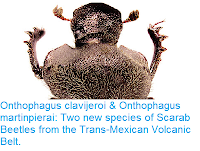Soldier Beetles, Cantharidae, are
a large and diverse group of brightly coloured, soft-bodied, Beetles found on
every continent except Antarctica. They are most commonly found in forested
environments, where they feed on leaf-dwelling invertebrates and pollen and
nectar from flowers. Soldier Beetles have a fossil record dating back to the
Early Cretaceous, though most fossil Soldier Beetles known are from
post-Cretaceous deposits. The Malthininae are one of five subfamilies of
Soldier Beetles, distinguished by a smaller size, reduced elytra (wing cases)
leaving the ends of the wings exposed, and a habit of mating abdomen-tip to
abdomen-tip, rather than with the male on top as in other groups.
In a paper published in the
journal Cretaceous Research on 15 September 2016, Yun Hsiao of the Departmentof Entomology at the National Taiwan University and the State Key Laboratory of
Biocontrol, Ecology and Evolution at Sun Yat-Sen University, Adam Ślipiński
of the Australian National Insect Collection, Congshuang Deng, also of the State
Key Laboratory of Biocontrol, Ecology and Evolution at Sun Yat-Sen University,
and of the College of Life Sciences at Capital Normal University, and Hong Pang,
again of the College of Life Sciences at Capital Normal University, describe a
new species of Malthinine Soldier Beetle from Late Cretaceous Burmese Amber.
The new species is named Archaeomalthodes rosetta, where ‘Archaeo-’ means ‘ancient’, ‘Malthodes’ is the name of the genus from
which the Malthininae gets its name, and ‘rosetta’
refers to the Rosetta Stone, which provided the key to deciphering the
Hieroglyphic script of Ancient Egypt, in the hope that the discovery of this
species plays a similar role in deciphering the evolutionary history of the Cantharidae.
The species is described from a single male specimen, 2.50 mm in length, from a
piece of amber from Kachin State in Myanmar, from deposits which have been
calculated to have a maximum age of 98.79 million years old.
Archaeomalthodes rosetta, in
Upper Cretaceous amber from Myanmar, lateral view. Scale bar is 0.5 mm. Hsiao et al.
The oldest known Soldier Beetle comes from Hammana/Mdeirij Amber from Central Lebanon, which is dated to about 125-135 million years ago (Early Cretaceous); however this specimen lacks the hind part of its body is missing, preventing the assigning of this specimen to any group. The oldest Soldier Beetles that can be assigned to any such group have come from Late Cretaceous Burmese Amber, with a prior specimen referred to the Subfamily Cantharinae. The discovery of a second subfamily in Burmese Amber suggests that they had begun to diversify by this point, which implies that ecological roles common to different groups, such as feeding on pollen and nectar, had probably also arisen by this time.
See also...
Follow Sciency Thoughts on Facebook.







